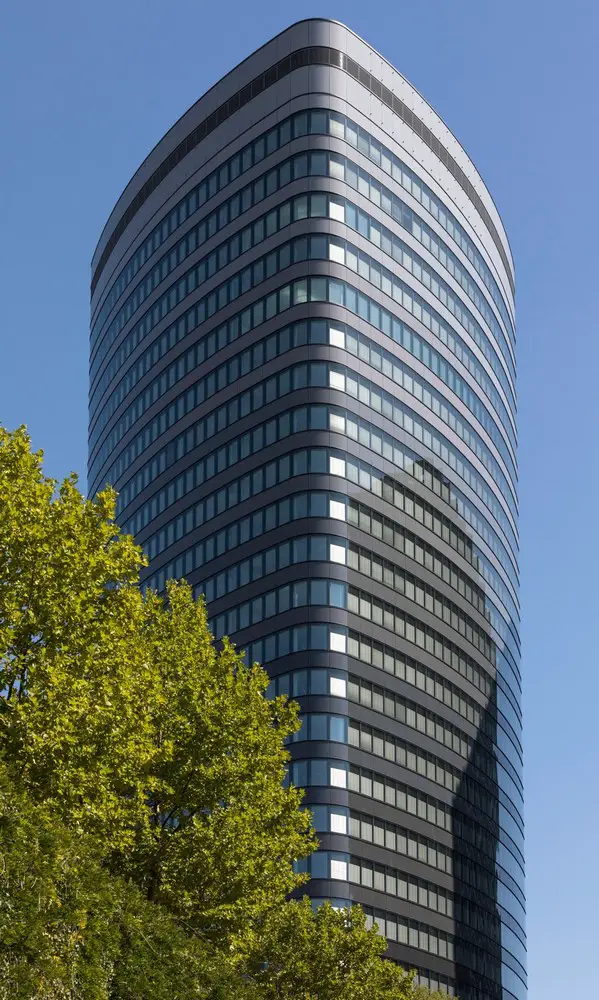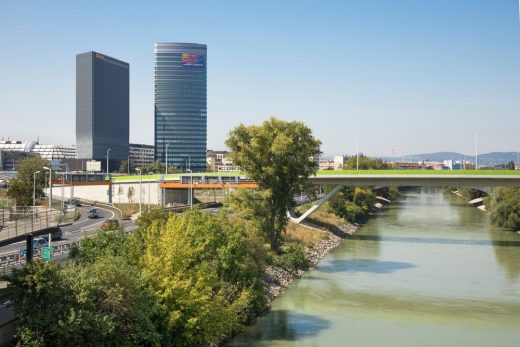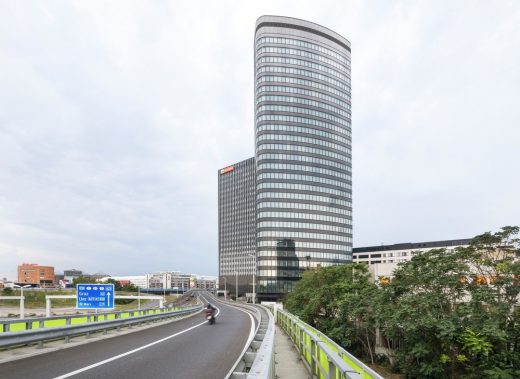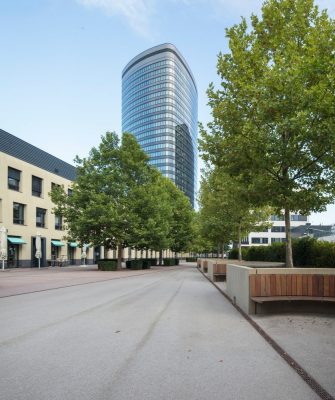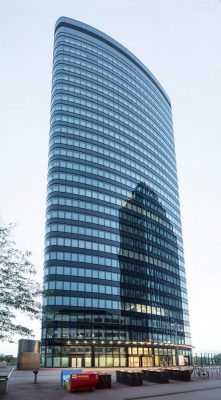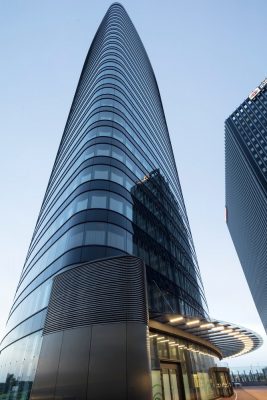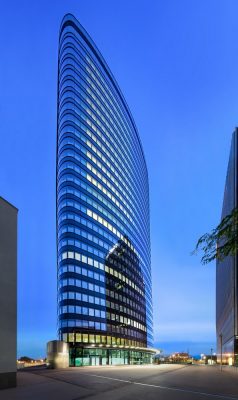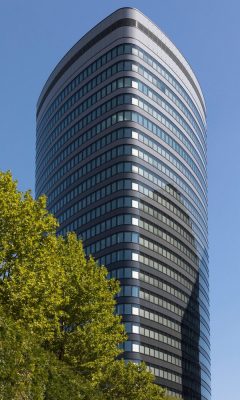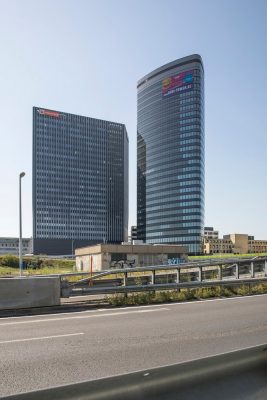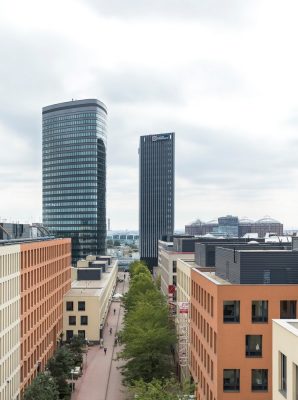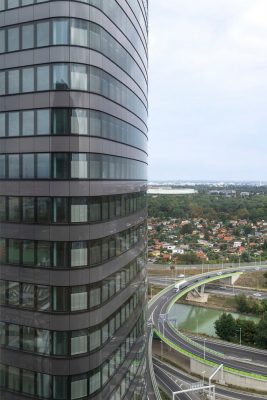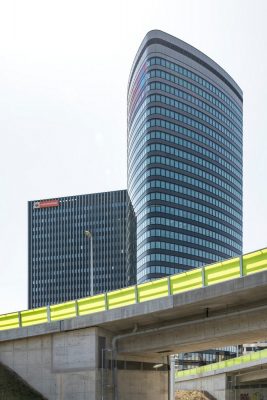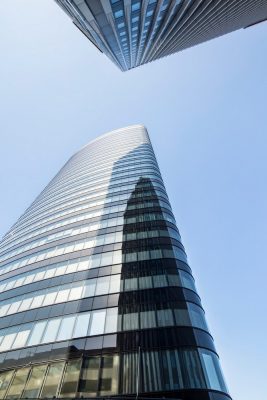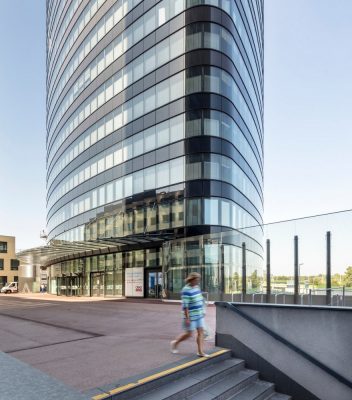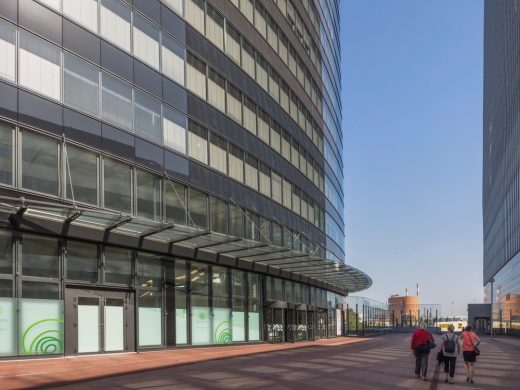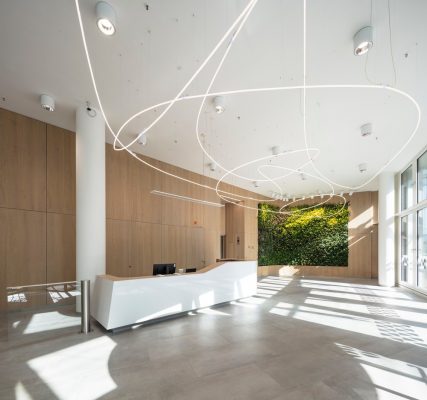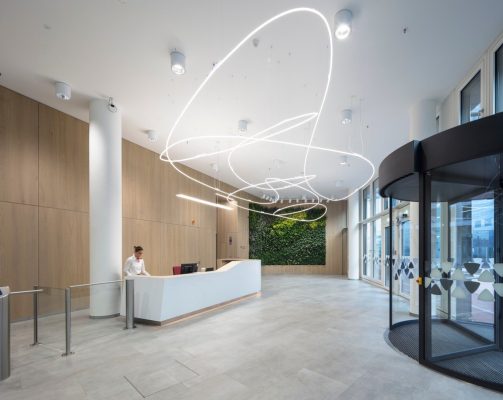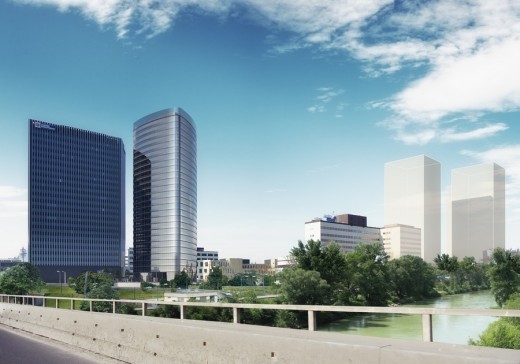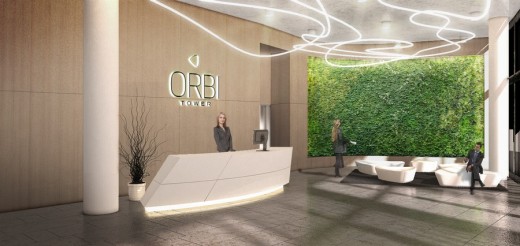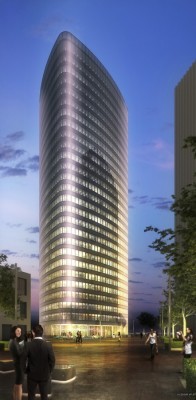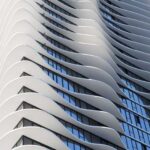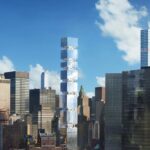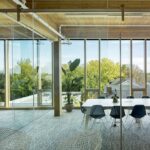ORBI-Tower, Vienna Building, Austrian Project, Design, Images, Competition Winners
ORBI-Tower Building: Offices
High-Rise Office Development Vienna – design by Zechner & Zechner, Architects
16 Nov 2017 + 30 Jun 2015
ORBI-Tower in Vienna
Design: Zechner & Zechner ZT GmbH
Location: Vienna, Austria
New world of work – the ORBI tower Vienna, designed by Zechner & Zechner architects has been completed
Photos: www.pierer.net
After winning the 2013 architectural competition, construction started in 2015, and the office tower was completed in 2017. The project developers were Wiener Stadtwerke Holding AG, and STC – Swiss Town Consult AG.
The ORBI Tower is located in Vienna’s “TownTown” urban development zone on the fringes of the Prater, a local recreation area and the green axis of the Danube Canal. It takes seven minutes to travel from the 115 m high tower to St. Stephen’s Square (Stephansplatz) by urban transport. The airport is just a 12 minute carried away. The tower boasts 21 600 sqm of office space for rent on 26 floors.
The project provides a tower rising from a trilobate, an orbiform, which together with the existing neighbouring tower forms a gate-like close to the TownTown-Piazza while at the same time also acts as a salient head in the southeast direction. One broadside of the trilobate points towards the Piazza in the direction of the entrance to the underground station thus marking the main access to the building and defining an attractive forecourt. One narrow side is oriented towards the east and acts as a curve to the motorway junction.
The tower is a simple large form, yet dynamically curved in the horizontal section with smooth, rounded surfaces. The building’s aerodynamic base form with its curves drawn into space through its horizontal structuring is engaged in a dialogue with the curves of the adjacent motorway section. In contrast to the crystalline structure of the neighbouring buildings the project acts as a mediating design element to this transport infrastructure object.
The facade is a band double facade offering mobile, wind-protected external solar protection. The colour of the glazed parapets gradually changes from bottom to top so that the building shows a soft colour progression from dark to light grey over its entire height. This optical effect “dematerialises” the building as it rises further up.
The building’s internal configuration is largely determined by the need of compact traffic areas and office space allowing for maximum flexibility in organisation. This requires an optimised structural and installation core at the centre with a circumferential, freely usable space.
Essential design criteria are related to the claim for a sustainable building, taking ecological factors into account. The building will been certified according to ÖGNI. The focus is on an efficient use of energy, water, and other resources, protection of user health, and a reduction of waste and undesired emissions. For the benefit of energy efficiency the use of passive systems is at the centre to reduce the necessary share in technical systems to a necessary extent and thus keep lifetime costs low.
The activated concrete ceilings in the building part function as a release system for heating and air conditioning. The three lower floors house the storage and engineering facilities as well as the parking area for passenger cars. On the ground floor public facilities and catering establishments are located next to the lobby also stretching through to the first floor. Upper floors 2 to 25 are designed as individually divisible office spaces. The selected building depth and configuration of the inner cores allow for a wide range of different forms of office organisation providing maximum flexibility.
Thanks to its high flexibility the reversible office strategy has proved to be an optimised concept for investors which is easily adaptable to the wishes of individual users and as such generates high sustainability. Today the portion of communication zones and flexibly used spaces must be substantially higher than in classical offices as employees are less and less tied to their workplace. Rather than standard desks and office cabinets the furniture recalls flats, restaurants, or recreational premises. Chill-out zones and creative areas alternate with computer work stations.
In the emergency exit staircase bright colours and posted slogans encourage stair climbing, athletic success can be verified on each floor with heart beat sensors.
Photography: www.pierer.net
Construction started for the new ORBI-Tower
After emerging as competition winners in 2013, Vienna based architects Zechner & Zechner were commissioned with the design of the 115m-tall ORBI-Tower high-rise project. Now construction has started for the new tower.
On the journey from Vienna’s airport to the city centre there is no avoiding the urban-development project TownTown, where the new tower is located. Due to its prime position, the new high rise will be a welcoming sight to a large proportion of people arriving in Vienna by plane.
The project is planned to be a tower based on a curve of constant width. It and the neighbouring building will form a gate-like boundary to the square and an impressive end structure towards the south east. One point of the curve of constant width points toward the square, in the direction of the subway station entrance, marking the main entrance to the building, and defining an attractive plaza. Another narrow aspect points, like a prow, to the south east and the motorway junction.
The tower appears simple, but has a large-scale, dynamically shaped horizontal cross section with smooth, rounded surfaces. The streamlined form of the building, and the way it curves through space due to its horizontal structure, was a design choice made in response to the curves of the adjacent motorway junction. In contrast to the crystalline structure of the surrounding buildings, the project functions as an expressive design element in relation to this transport infrastructure.
The interior configuration of the building is, in essence, determined by the need for compact thoroughfares and the highest flexibility in organisation of office space. This requires a compact internal core for access and building services, with surrounding open spaces.
The most important design criteria stem from the requirement for a sustainable building that takes green factors into account. It is intended that the building will be ÖGNI/DGNB certified. The foremost factors are the efficient use of energy, water and other resources, safeguarding the health of the building users, as well as reducing waste and unwanted emissions. High energy efficiency is provided primarily by using passive systems to reduce the reliance on technological systems to a minimum and keep life-cycle costs down.
The three below-ground floors contain storage, building services and parking areas. On the ground floor, a foyer, public spaces and eating and drinking are planned. The upper floors, 1 to 25, are designed to be office space that can be divided up individually. The chosen depth of the building and configuration of the interior core allow maximum flexibility and many different office layouts. The strategy of reversible offices emerged as the solution that best optimised investment, due to their high flexibility, and ease of customisation to fit the requirements of individual users, thus providing high sustainability.
The facade is designed as a modular double-skin facade. The outer glazing has a fine pattern of dots, which creates a soft transition from opaque areas to transparency across the height of the building. This optical effect ‘dematerialises’ the building as it gains in height.
ORBI-Tower in Vienna images / information from Zechner & Zechner
Location: Vienna, Austria
New Vienna Architecture
Contemporary Viennese Architecture
Vienna Architecture Design – chronological list
Vienna Architecture Tours by e-architect
Telegraf 7 Building, Lehargasse
Design: BEHF Architects
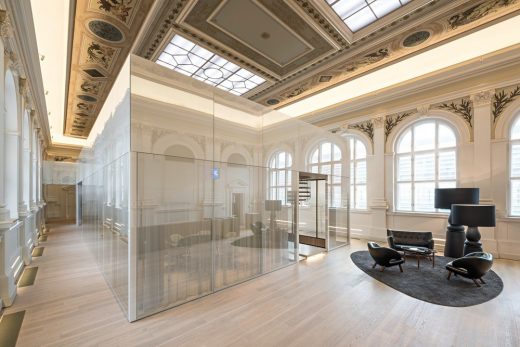
photograph : Hertha Hurnaus
Telegraf 7 Building in Vienna
University of Economics & Business Vienna : design competition
Vienna Architecture Walking Tours
Comments / photos for the ORBI-Tower in Vienna Architecture page welcome
Website: Zechner & Zechner
Website: ORBI-Tower

